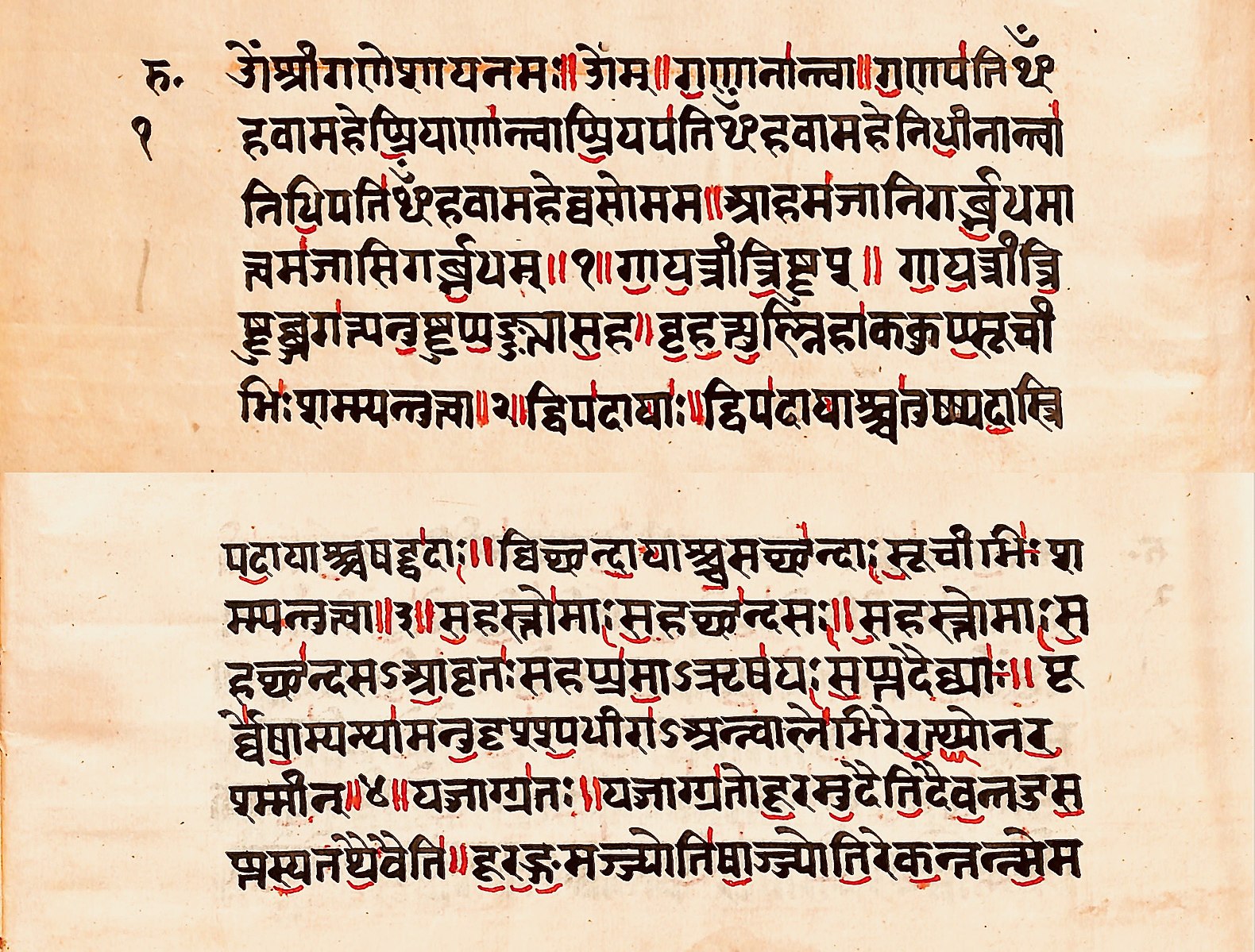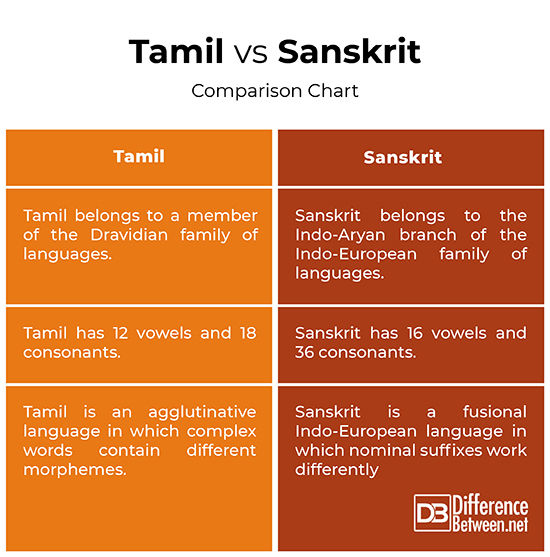Difference Between Tamil and Sanskrit
Which language came first – Sanskrit or Tamil? It’s an unlikely debate that has raged for centuries. In the past, most have simply assumed that Tamil language must have borrowed from Sanskrit. But, no proper analysis has been made to prove its certainty. Anyone who is familiar with the Sanskrit literature is quite certain of the fact that the earliest of Tamil literature does not seem to be much influenced by Sanskrit. Each of the language is very different unless you go back to earliest human evolutions.

Description of Tamil
Tamil is one of the ancient languages and a member of the Dravidian language family, natively spoken today by over 70 million people in South India, Sri Lanka, and a large diaspora that includes Singapore, Malaysia, South Africa, Fiji, Toronto, Paris, and other sites throughout the world. Tamil is also the official language of the Indian state of Tamil Nadu and the union territory of Pondicherry (Puducherry). Tamil has retained many of its defining features of the original Dravidian language spoken predominantly by the Tamil people in India and Sri Lanka. Tamil is believed to be the oldest language of the Dravidian family and amongst the oldest living languages of the world. According to the Scholars, Tamil language history can be divided into three periods: the Old Tamil (300 BCE to 700 CE), the Medieval Tamil (700 CE to 1600 CE), and the Modern Tamil (1600 CE to present).

What is Sanskrit all about?
Sanskrit is one of the oldest languages of the ancient India and a member of the Indo-Aryan branch of the Indo-European languages. The term Indo-Aryan, as applied to language, covers the totality of languages and dialects derived from the sources from the earliest times to the present day. The language has a documented history that dates back to as far as 3,500 years ago. Sanskrit is the primary liturgical language of the Hinduism and is believed to be the most systematic and technical language of all. Sanskrit is believed to have been originated as Vedic Sanskrit, which is the language of the Vedas (the oldest scriptures of Hinduism). Sanskrit is a very powerful and versatile language that has the power to express something using the minimum number of words.
Difference between Tamil and Sanskrit
Language Family that Tamil and Sanskrit belong to
– Tamil belongs to a member of the Dravidian family of languages spoken primarily in India, particularly South Asia. Dravidian is a language family of over 70 languages spoken by about 220 million people in southern and central India, and north-east Sri Lanka. Sanskrit belongs to the Indo-Aryan branch of the Indo-European family of languages. The Indo-Aryans were a branch of the Indo-Iranians and most of their languages derive their high-level vocabulary from Sanskrit.
Syntax
– Tamil, like other Dravidian languages, is agglutinative meaning it has a morphological system in which words may contain different morphemes, with a high morpheme-to-word ratio. This basically means that suffixes are added sequentially to specify meaning and syntactic function, usually without modifying the initial stem. For instance, the word ‘remarkably’ has three morphemes – remark + able + ly. Sanskrit, on the other hand, is a fusional Indo-European language wherein the nominal suffixes work very differently.
Pronunciation
– Pronunciation is subtly different in both the languages. Tamil has three letters to represent the N sound, three for L, and two for R. This is mostly the same in Malayalam and Old Kannada languages. The letter ‘k’, for example, represents ‘k’ but can also be pronounced ‘g’ or ‘h’. The pronunciation of ‘k’ varies greatly depending on the placement of the letter in the word. Sanskrit seems to show a variety of ways of forming words. Although, the vowels of both the languages are almost the same, Sanskrit has extended consonants.
Tamil vs. Sanskrit: Comparison Chart

Summary of Tamil and Sanskrit
The resemblance between the two literatures is not enough to indicate direct borrowing. Evidence suggests that both Tamil and Sanskrit derived their shared conventions and techniques from a common source, for it is clear that neither of them borrowed directly from the other. Tamil is a Dravidian language whereas Sanskrit is Indo-Aryan. Both are very different unless you go to earliest human evolutions. Sanskrit is probably the oldest language of ancient India, but Tamil is the oldest surviving ancient language of the world.
Is Tamil and Sanskrit same?
No, Tamil and Sanskrit are not same. Tamil language belongs to a member of the Dravidian language family, natively spoken today by over 70 million people in South India. Sanskrit is a dialect of the Old Indo-Aryan language.
Is Tamil originated from Sanskrit?
Tamil is not derived from Sanskrit, although there are many common words found in both.
Which is the first language in the world Tamil or Sanskrit?
Sanskrit is believed to be one of the oldest languages dating back to 5000 years, but it fell out of prominence around 600 BC. It is now a liturgical language of the Hinduism. Tamil is one of the oldest languages of the Dravidian family. Which came first – Tamil or Sanskrit? This has always been a hot topic of debate since ages.
Is Tamil mother of Sanskrit?
Tamil is not the mother of Sanskrit. Although, many believe Tamil is the mother of all languages. Sanskrit is the Divine language of Hinduism.
What is the mother of all languages?
Sanskrit is believed to be the mother of all languages. It is a very versatile language that has the power to say something using a minimum number of words.
Which is the first language in world?
Languages have been around for way too long of a time, even beyond the dawn of civilizations. Sanskrit and Tamil are among the oldest languages in the world. Tamil is one of the oldest classical languages to survive the wheels of time. But, which one came first? The answer to this question is not simple at all.
- Difference Between Caucus and Primary - June 18, 2024
- Difference Between PPO and POS - May 30, 2024
- Difference Between RFID and NFC - May 28, 2024
Search DifferenceBetween.net :
Leave a Response
References :
[0]“Tamil language.” Wikipedia, Wikimedia Foundation, 27 Sept. 2021, https://en.wikipedia.org/wiki/Tamil_language. Accessed 7 Oct. 2021.
[1]“Sanskrit.” Wikipedia, Wikimedia Foundation, 3 Oct. 2021, https://en.wikipedia.org/wiki/Sanskrit. Accessed 7 Oct. 2021.
[2]Shulman, David. Tamil: A Biography. Massachusetts, United States: Harvard University Press, 2016. Print
[3]Hart, George L. The Relation Between Tamil and Classical Sanskrit Literature. Leipzig, Germany: Harrassowitz Verlag, 1976. Print
[4]Krishnamurti, Bhadriraju. The Dravidian Languages. Cambridge, UK: Cambridge University Press, 2003. Print
[5]Burrow, Thomas. The Sanskrit Language. New Delhi, India: Motilal Banarsidass Publishers, 2001. Print
[6]Houben, Jan E.M. Ideology and Status of Sanskrit: Contributions to the History of the Sanskrit Language. Leiden, Netherlands: Brill, 1996. Print
[7]Image credit: https://commons.wikimedia.org/wiki/File:Tamil_2.jpg
[8]Image credit: https://commons.wikimedia.org/wiki/File:Yajurveda_44.8,_page_1_front_and_back,_Sanskrit,_Devanagari_lipi_(script).jpg
